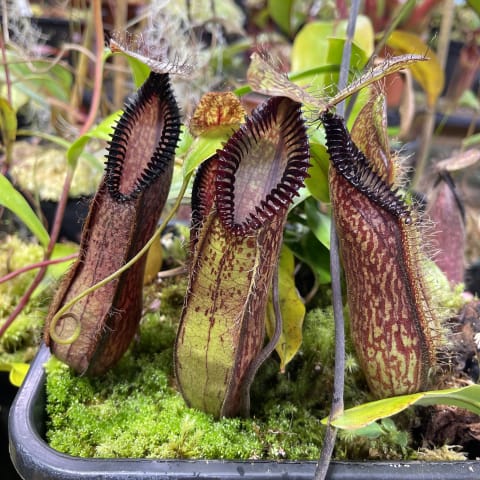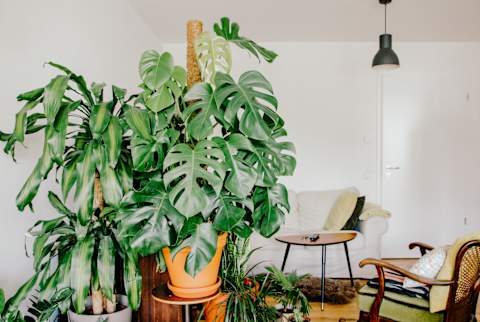
Our editors have independently chosen the products listed on this page. If you purchase something mentioned in this article, we may earn a small commission.
December 16, 2021 — 12:35 PM
There are tons of plants that can lend life to your at-home jungle, but none recreate that forest floor feeling quite like an asparagus fern. This light, feathery plant makes for a unique addition to any garden, indoor collection, or hanging houseplant display. Here’s how to keep it happy.
Asparagus ferns (Asparagus setaceus) are native to the forest floors of southern and eastern Africa. “In the wild, they grow as a perennial shrub in subtropical conditions,” Paris Lalicata, plant education coordinator at The Sill, tells mbg.
Asparagus ferns’ native habitat tells you about the conditions it craves: warm, humid, sunny environments that also have a bit of shade.
Despite its name, the plant does not resemble asparagus—and it’s actually not even really a fern! Instead, it’s part of the asparagaceae family, along with other popular flowering plants like agave and dracaena. And while its foliage resembles a fern, it doesn’t reproduce via spores as true ferns do.
Another thing that sets this plant apart is its tuberous roots: These bulblike root structures act as little storage containers for the plant, saving resources for when they’re most needed. Adaptations like these make asparagus ferns relatively hardy and low maintenance and allow them to grow quickly given the right care.
While it’s not the most popular type of greenery out there, chances are you can find an asparagus fern for sale in your local plant shop or garden store.
- Sunlight needs: Bright to medium indirect light
- When to water: Every 1 to 2 weeks in winter; 1 to 2 times a week in summer
- Pros: Quick to grow, hardy
- Cons: Can be finicky about humidity levels
- Where to put them: Within 3 feet of a sunny window that gets some shade
- Pet-friendly? Toxic to cats and dogs according to the ASPCA
- Size: Can grow to be 2 to 3 feet tall and 5 to 6 feet wide
Planting & growing an asparagus fern.
probiotic+
Tackle your gut issues now, so you don’t have to think about them later.*

Since they can be such prolific growers, asparagus ferns are actually considered an invasive species in some states, including Florida, Texas, Hawaii, and California. Before planting it in your yard, consider how it will affect the local environment and maybe opt for a native variety instead.
If you do choose to move forward with the asparagus fern, Debbie Neese, the horticulture expert at Lively Root, recommends placing it in a spot that gets four to six hours of partial morning sun and afternoon shade. “In full sun, it could survive but would need high humidity and moisture content in the soil,” she says.
This tropical plant will thrive year-round in USDA Hardiness Zones 9-12. If you live in a cooler environment, you’ll need to take it inside for the season once temperatures dip below 55 degrees Fahrenheit.
Since it prefers humid environments, those who live in really dry conditions would be better off keeping this one as a houseplant.
As a houseplant, the asparagus fern likes bright to medium light. It would be happy next to a window that gets four to six hours of sun a day, with a little shade thrown in.
Set your indoor temperature around 60 to 75 degrees to keep these plants happy, and be sure to give them plenty of humidity during drier months (by misting or placing them near a humidifier). Don’t put them too close to drafty windows or air conditioning/heating units, as these can also dry out their leaves.
Caring for it as a houseplant.
Here, Neese and Lalicata weigh in on how to care for the asparagus fern so it lives its longest, most vibrant life indoors.
Like many tropical plants, this one appreciates moist conditions—but, Lalicata cautions, “that doesn’t mean you shouldn’t let its soil ever dry out.” Wait until the top 2 to 3 inches of your plant’s soil feel dry to the touch before giving it a good soak.
Depending on the plant, you’ll likely need to water every one to two weeks in the winter and as many as two to three times a week in the summer.
This is one plant that can handle a regular misting. Its thin, feathery leaves make it less likely to develop fungal infections from the added moisture, Lalicata explains.
Every time you water it, feel free to give its leaves a good mist to make sure it’s getting enough moisture and humidity. You can also place it within striking distance of a humidifier to achieve the same effect.
Neese recommends placing this plant near an east- or north-facing window that gets a medium amount of sunlight. While Lalicata says that it can handle bright, direct light, it will be happier in conditions that mimic the dappled shade of its native habitat.
Aim to keep this plant in a spot that stays around 60 to 75 degrees Fahrenheit. In the winter and summer months, don’t place them too close to air conditioners or heaters.
This plant isn’t finicky about soil, and Lalicata says that any standard indoor potting mix should do the trick. If anything, she says you can add some extra perlite or vermiculite to further aerate the soil and provide some extra drainage. (If you do, keep in mind that you might have to water your plant more frequently.) She adds that a loam soil—a mix of sand, silt, and clay—can also work for this plant.
Every year, preferably in spring, aim to change out its soil to give it a fresh infusion of nutrients. Fertilizing it every two to four weeks during the growing season with a well-balanced fertilizer, or one with a slightly higher nitrogen ratio, will also protect against any soil deficiencies.
As you’re changing out your plant’s soil, make sure it hasn’t outgrown its pot. If you notice its roots are jammed against the side of the pot and curling in on each other, it probably needs a container that’s 1 to 2 inches larger in size. Always use a pot with drainage holes.
To repot, Neese recommends putting on a pair of gloves (the leaves might get prickly), lifting the plant from its pot, and gently brushing off any excess soil before placing it in its new home. If you’re new to this technique, check out mbg’s complete guide to repotting here.
Common problems & how to fix them.
If you follow the aforementioned guidance, your asparagus fern should be in great shape. But of course, slip-ups can always happen. Here are a few red flags that it’s time to adjust your care routine slightly:
- Browning, crisping leaves: The tricky thing about plants is that one issue could have many causes. Take brown, crispy leaves: Lalicata says that these can be a sign that your plant is too dry and needs extra humidity or that it’s receiving too much or too little water. Feel its soil and consider your home’s humidity levels (it’s surprisingly easy to test) to get a sense of what it’s trying to tell you.
- Excessive leaf drop: If you notice your plant’s leaves are falling off at a fast clip, it could be a sign that it isn’t getting enough light or needs more humidity. Shedding could also be a sign that it’s getting too much light. Again, consider the care you’ve been giving it and go from there.
- Yellowing: A little leaf yellowing every once in a while is no big deal, but if you notice that many of your plant’s leaves are turning yellow, it could be either an overwatering or a nutrient deficiency issue. “Usually a nutrient deficiency will only occur primarily at the lower, older leaves, and they’ll start to turn a pale yellow,” Lalicata says. If this is the case for you, consider upping your fertilizer routine or swapping tap water for distilled on watering day.
Remember those little tubers mentioned earlier? They made asparagus ferns a total breeze to propagate. Unlike plants that can divide via stem cutting like a philodendron or pothos, you’ll want to split up the asparagus fern at the root level. Here’s how it’s done:
- Newspaper or a cloth to cover your work area (this will get messy!)
- A small pot with a drainage hole
- Well-draining potting mix
- Do your propagation as you’re refreshing your plant’s soil or putting it in a new pot to minimize stress to the root system.
- Shimmy your plant out of its pot. Shake off its extra soil and place it on your work area.
- Gently split your plant at the roots: Using your hands or a knife, remove a section of the plant that has at least two to four stems, doing your best to keep those tuber structures intact.
- Place this section of your plant in your new pot with fresh soil. Give it a little extra water and moisture during those first few weeks to help it grow faster. Voilà, two asparagus ferns, coming right up!
To recap, here are the main tips to keep in mind when caring for your asparagus fern:
- Allow its soil to dry out completely during waterings. If you’re unsure of when to water, Neese recommends investing in a moisture meter.
- Make sure that your plant is getting some extra humidity—especially if the air in your home is dry. Place it within a few feet of a humidifier, or mist its leaves regularly.
- Don’t give your plant too much light. If you notice brown, crispy leaves or excessive leaf drop, it could be time to move it to a slightly shadier area.
Despite bearing no resemblance to asparagus (and limited relations to ferns), asparagus ferns are still a fun plant to add to your collection. Stay on top of its watering schedule and humidity levels and you’ll keep the wispy wonder happy for years to come.
Want to learn how feng shui can help you create a high-vibe home and set powerful intentions to manifest your dreams? This is feng shui the modern way – no superstitions, all good vibes. Click here to register for a free session with Dana that will give you 3 tips to transform your home today!
Reset Your Gut
Sign up for our FREE doctor-approved gut health guide featuring shopping lists, recipes, and tips
You are now subscribed
Be on the lookout for a welcome email in your inbox!
https://www.mindbodygreen.com/articles/asparagus-fern







